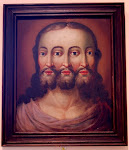I was browsing Facebook today after the longest time when a friend left me a message, telling me to visit a group so despicable and insufferably foolish that I felt my blood pressure go up a couple of notches. I will not name the group in question as I shudder to think, even now, what possessed me to go over there and check it out. This group was made doubly loathsome in my eyes as it claimed to espouse traditional Catholic values.
Now, I've made my share of mistakes in the past. I've swung from one end of the political spectrum to the other, extreme liberalism changing almost overnight to fascism. There was a time when I would read the New York Times and Stormfront simultaneously. But if there's one thing I am proud to say that has been constant in my thinking, it is being level-headed. And while I am quite proud to declare that I can be a very opinionated person, in no way would I ever seek to make my own opinion the sole, dogmatic barometer of truth. Like many extremist traditionalist cliques, this Facebook group seems to dwell in a make-believe land where everyone speaks in Victorian prose and wears three-piece suits to dinner and drinks to the damnation of the enemies of the Faith. What a diseased way of thinking about the Faith! How horribly elitist and uncharitable!
All this seems to prove my theory that traditionalism is not so much an attempt to live as Catholics of yore did, but is, rather, a frankly distorted politics of delineation and isolation. There is a story of a city in Italy where a band of lepers, en route to an important shrine, had decided to settle, in the hopes of enticing the charity of the townsfolk in aiding their plight. However, no matter how long they waited, the citizens, because they were also so poor, could not gather enough money to help the beggars on their way. It eventually came to pass that the relics of St. Martin of Tours were to pass by the city in procession; and hearing this, the beggars fled and hid from the bones of the saint, crying out that the saint was come to rob them of their livelihood.
I'd like to think that traditionalism, or indeed any kind of movement, is genuine; but groups such as this seem to give the impression that it is better to remain in isolation, for only in such gatherings of the 'righteous' can the Truth appear. This is a very warped way of thinking, one that is corrupt and not at all Christian. And while certainly book-burning and censorship are historically verifiable facets of Christian history, to define the revealed Faith of Christ in the terms of repression would be a great disservice to all. It is sick. It is malicious. Below, I have included select quotes from some of the discussions from that particular group. God help us all if this is what being traditional means to these people.





























